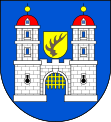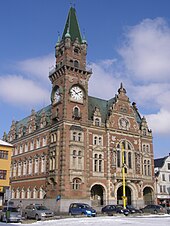Frýdlant v Čechách
| Frýdlant | ||||
|---|---|---|---|---|
|
||||
| Basic data | ||||
| State : |
|
|||
| Historical part of the country : | Bohemia | |||
| Region : | Liberecký kraj | |||
| District : | Liberec | |||
| Area : | 3162 ha | |||
| Geographic location : | 50 ° 55 ' N , 15 ° 5' E | |||
| Height: | 295 m nm | |||
| Residents : | 7,531 (Jan 1, 2019) | |||
| Postal code : | 464 01 | |||
| License plate : | L. | |||
| traffic | ||||
| Railway connection: |
Liberec – Zawidów Frýdlant v Čechách – Jindřichovice pod Smrkem narrow-gauge railway Frýdlant – Heřmanice (discontinued) |
|||
| structure | ||||
| Status: | city | |||
| Districts: | 3 | |||
| administration | ||||
| Mayor : | Dan Ramzer (as of February 8, 2007) | |||
| Address: | TG Masaryka 37 464 01 Frýdlant |
|||
| Municipality number: | 564028 | |||
| Website : | www.mesto-frydlant.cz | |||
Frýdlant (German Friedland in the Jizera Mountains ) is a town in the Liberec district in Northern Bohemia ( Czech Republic ).
Geographical location
The city is located in northern Bohemia , in the Jizera Mountains foothills (Frýdlantská pahorkatina), at the confluence of the Řasnice (Rasnitz) in the Smědá (Wittig) at the foot of the castle hill.
history
The area around Friedland was probably settled by Slavic settlers from Lusatia in the 6th century . As part of the Gaus Zagost, it belonged to the possessions of the Bishops of Meissen around the town of Seidenberg . In 1158 the area became part of Bohemia . In the place of the city there was originally a fishing village. According to tradition, Friedland Castle is said to have been built by Vladiken Berkowetz von Diewitz in 1014 and the Indica castle tower dates from this time.
The first written mention of the place took place in 1278, when the Lords of Bieberstein moved the seat of the Seidenberg rulership to Friedland. Schloss and Herrschaft Friedland belonged to the Lords of Bieberstein until 1551, then the region was owned by the Lords of Redern until 1620 . This rule was withdrawn in the course of the Catholic Counter-Reformation of Bohemia . Albrecht von Wallenstein received it from Emperor Ferdinand II in 1620, initially as a pledge, and in 1622 finally bought it from the imperial treasury. The rule was paid for with the so-called long coin , the inflation money of the years 1621/22. In 1623 he was then awarded the title of Duke of Friedland . This also saw the separation of the Friedland-Seidenberg rule. The place belonged from the middle of the 19th century to the judicial district Friedland or the district Friedland .
Until then, it belonged to the crown land of Bohemia, Austria-Hungary , but after the First World War in 1919 the city fell to the newly founded Czechoslovakia with the majority of the German population .
The town of Friedland had 6,314 inhabitants on December 1, 1930 (563 of them Czechs = 9%); on May 17, 1939 there were 5,829. After the Munich Agreement in 1938, the city came to Germany as part of the Sudetenland and was given the new official name Friedland (Jizera Mountains) in 1939 . Until 1945 it was the seat of the Friedland district in the Jizera Mountains , Aussig district , in the Reichsgau Sudetenland .
After the Second World War Friedland came back to Czechoslovakia and was renamed Frýdlant v Čechách.
Due to the Beneš decrees in 1945, the German-Bohemian residents of Friedland were expropriated and mostly expelled .
With the arrival of Czechs, the number of inhabitants decreased only slightly after the expulsion; on May 22, 1947, the city had 4,308 residents.
Demographics
Until 1945 Friedland in the Jizera Mountains was predominantly populated by German Bohemia , who were expelled.
| year | Residents | Remarks |
|---|---|---|
| 1830 | 3,197 | in 549 houses |
| 1834 | 3,300 | |
| 1857 | 4,259 | on October 31st |
| 1900 | 6.241 | German residents |
| 1930 | 6.314 | including 563 Czechs |
| 1939 | 5,844 |
City structure
The city of Frýdlant consists of the districts
- Albrechtice u Frýdlantu ( Olbersdorf , popularly also called Wüstullersdorf ) with Filipov ( Philippsberg )
- Frýdlant with Hág ( Hag ) and Údolí ( Jäckelsthal )
- Větrov ( ring grove ) with Dolní Větrov ( lower ring grove ) and Horní Větrov ( upper ring grove ).
Basic settlement units are Albrechtice u Frýdlantu, Dolní Větrov, Filipov, Frýdlant-střed, Fügnerova, Hág, Harta, Horní Větrov, Pod Špičákem ( field houses ), Předměstí, Supí vrch, U nádraží, U nádraží, U nášdíu, U nášdí ( Non-houses ).
The municipality is divided into the cadastral districts Albrechtice u Frýdlantu and Frýdlant.
Attractions
Friedland Castle and Palace
The castle Friedland probably originated in the mid-13th century. In addition to Waldstein (Wallenstein), the lords of Dubá , Bieberstein and Redern were among the most important noble families to whom the castle belonged . In the oldest Central European castle museum, furniture, glass, porcelain and especially weapons from the Hussite period to the 19th century are on display.
Church of the Finding of the Cross
The former deanery church (Czech Kostel Nalezení sv. Kříže ) was built in the years 1549–1551 by the Lords of Bieberstein. To the right of the altar are three large epithapies for Hieronymus Freiherr von Bieberstein († 1549), Johann Freiherr von Bieberstein († 1550) and Christoph von Bieberstein († 1566). In their chapel is the crypt of the von Redern family from 1566. Between 1605 and 1610, the Wroclaw sculptor Gerhard Heinrich created the Redern mausoleum. Katharina von Redern had her deceased husband Melchior von Redern erect a monumental monument made of marble, alabaster and bronze for 37,000 thalers.
After completion, a printed description of the monument was published in Görlitz and Breslau. In 2001 a drawing was found in the old scientific holdings of the Christian-Weise-Bibliothek Zittau , which probably represents the first draft of this.
town hall
The town hall in Friedland was built in the years 1893-1896 in the neo-renaissance style by the Viennese architect Franz Neumann . There is a city museum on the second floor.
Nativity scene Bethlehem
The Friedland Christmas crib was created by Gustav Simon (1873–1953) over a period of 60 years. It is located on the outskirts of the city center, somewhat hidden on the Zahradní , a side street, in the Bethlehem house ( Betlém ). The small half-timbered house is also one of the oldest structures in Frýdlant.
More Attractions
- Church of St. Mary Magdalene (Czech Kostel sv. Maří Magdaleny , Orthodox)
- Plague column, built in 1899
- Lookout tower, 21 meter brick building on the Resselsberg ( U Rozhledny )
Town twinning
- Friedland (Mecklenburg) , Germany
- Friedland (Niederlausitz) , Germany
- Friedland (Lower Saxony) , Germany
- Frýdlant nad Ostravicí , Czech Republic
- Korfantów , Poland
- Mieroszów , Poland
- Pravdinsk , Russia
- Siekierczyn , Poland
sons and daughters of the town
- Josef Gottfried von Riedel (1803–1870), Austrian psychiatrist
- Wilhelm Franz Speer (1823–1898), composer, organist and choir conductor
- Emanuel Basler the Elder (1826–1903), German sculptor
- Josef Weikert (1837–1907), composer and church musician
- Alexander Bittner (1850–1902), Austrian geologist
- Franz Thiele (1868–1945), German painter
- Rudolf Beer (1911–1981), concentration camp leader
- Josef Blösche (1912–1969), SS Rottenführer
- Otto Kade (1927–1980), German translation scholar
- Ruthild Langhammer (* 1940), German painter
- Walek Neumann (* 1940), German open-air painter and wood cutter
- Rainer Lösch (* 1944), German botanist and university professor
- Jan Budař (* 1977), Czech actor, director, musician and screenwriter
- Jan Rajnoch (* 1981), Czech football player
- Tomáš Plíhal (* 1983), Czech ice hockey player
- Miroslav Tomeš (* 1985), Czech biathlete
- Karolína Bednářová (* 1986), Czech volleyball player
- Ladislav Šmíd (* 1986), Czech ice hockey player
- Antonín Hájek (* 1987), Czech ski jumper
literature
- Franz Némethy: The Friedland Castle in Bohemia and the monuments in the Friedland City Church; together with some old documents and handwritten letters from Duke Waldstein . Prague 1818 ( e-copy ).
- Ferdinand Bretislav Micowec: Friedland Castle and the castle ruins Bösig and Schreckenstein in Bohemia . Vienna and Ölmüz 1859 ( e-copy ).
- Jan Šícha, Eva Habel, Peter Liebald, Gudrun Heissig: Odsun. The expulsion of the Sudeten Germans. Documentation on the causes, planning and realization of an "ethnic cleansing" in the middle of Europe in 1945/46. Sudeten German Archive, Munich 1995, ISBN 3-930626-08-X .
Web links
Individual evidence
- ↑ Český statistický úřad - The population of the Czech municipalities as of January 1, 2019 (PDF; 7.4 MiB)
- ^ Rudolf Hemmerle : Sudetenland Lexikon Volume 4, page 154. Adam Kraft Verlag, 1985. ISBN 3-8083-1163-0 .
- ↑ Yearbooks of the Bohemian Museum of Natural and Regional Studies, History, Art and Literature . Volume 2, Prague 1831, p. 196, item 8).
- ↑ Johann Gottfried Sommer : The Kingdom of Bohemia . Volume 2: Bunzlauer Kreis , Prague 1834, p. 311, point 2).
- ↑ Johann Gottfried Sommer : Das Kaiserthum Oesterreich, represented geographically and statistically . Prague 1839, p. 134.
- ↑ Statistical overviews of the population and livestock in Austria . Vienna 1859, p. 39, right column .
- ^ Meyer's Large Conversational Lexicon . 6th edition, Volume 7, Leipzig and Vienna 1907, p. 111, item 8) .
- ^ A b Michael Rademacher: German administrative history from the unification of the empire in 1871 to the reunification in 1990. Friedland district on the Jizera Mountains. (Online material for the dissertation, Osnabrück 2006).
- ↑ http://www.uir.cz/casti-obce-obec/564028/Obec-Frydlant
- ↑ http://www.uir.cz/zsj-obec/564028/Obec-Frydlant
- ↑ http://www.uir.cz/katastralni-uzemi-obec/564028/Obec-Frydlant







